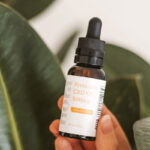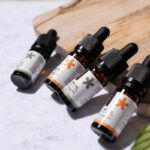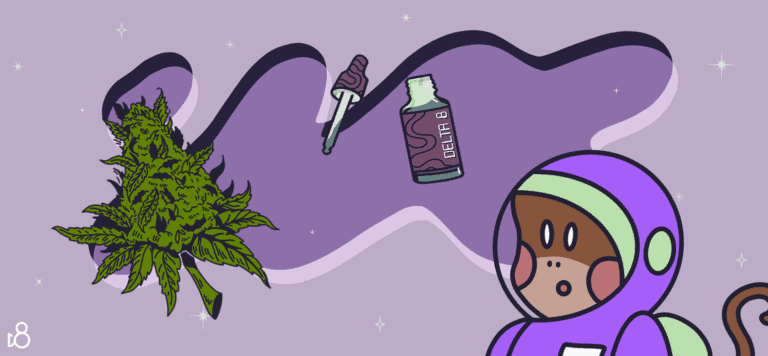CBD Statistics
CBD is taking the world by storm as a natural remedy for a ton of health issues. It’s sourced from the cool cousin in the cannabis family, so it doesn’t make you feel high.
CBD has been shown to be effective in treating anxiety, pain, and inflammation, and there is a growing body of scientific evidence to support these claims.
If you’re thinking about trying CBD oil, here are some statistics that might help you make your decision.
Delta-8 THC Products
Delta-9 THC Products
Delta-10 THC Products
Shop our top brands:
What is Cannabidiol/CBD
Cannabidiol (CBD) is one of many cannabinoids found in the cannabis plant. CBD is a non-intoxicating compound that has shown promise in a variety of medical applications, from pain relief to treating anxiety and depression.
While CBD does not produce the psychoactive effects that its cousin THC does, it is still federally illegal in the United States. However, more and more states are passing legislation to allow for the use of CBD for medicinal purposes.

Uses of CBD
CBD has been shown to be effective in treating a variety of conditions, including:
- Anxiety
- Depression
- Chronic pain
- Insomnia
- Epilepsy
- Parkinson’s disease
- Alzheimer’s disease
Is CBD us very common
In the United States, CBD is legal in all 50 states. CBD products are widely available online and in stores. A recent study found that nearly 7% of Americans use CBD.

CBD statistics in USA
A recent study found that the majority of CBD users in the United States are white, female, and live in urban areas. The study also found that CBD users are more likely to be college-educated and have higher incomes than the general population.
In addition to these findings, the study found that CBD users are more likely to suffer from anxiety and depression than the general population. This is likely due to the fact that CBD is often used to treat these conditions.
CBD statistics age wise
CBD has been shown to be effective in reducing anxiety and depression in people of all ages. A 2019 study showed that CBD was effective in reducing anxiety and improving sleep in children with anxiety disorders. A 2020 study showed that CBD was effective in reducing symptoms of social anxiety disorder in adults.
CBD statistics by method
CBD oil is the most popular way to consume CBD, with 34% of respondents saying they use it. This is followed by edibles (17%), topicals (14%), and vape products (12%).
Other methods of consuming CBD include capsules (11%), tinctures (9%), and creams/lotions (5%).
Health effects of CBD
CBD has been shown to be effective in treating a variety of medical conditions, including anxiety, chronic pain, and epilepsy. A growing body of research is beginning to explore the potential health effects of CBD.
CBD is known to interact with the body’s endocannabinoid system, which regulates a variety of functions including sleep, appetite, pain, and immune system response. CBD oil has been shown to be effective in reducing anxiety and improving sleep in children with post-traumatic stress disorder (PTSD).
A small 2010 study found that CBD oil was effective in treating symptoms of social anxiety disorder (SAD), such as fear of public speaking. The participants were given an oral dose of 400 mg of CBD oil or a placebo.

Those who received the CBD oil reported lower levels of anxiety and discomfort during their speech than those who received the placebo.
A 2012 study found that CBD may help reduce inflammation and pain in rats with arthritis. The rats were treated with transdermal CBD gel for four days. The study found that the rats treated with CBD had reduced inflammation and pain without any side effects.
A 2013 review looked at all the available evidence from animal studies and test-tube experiments to determine if CBD could help treat epilepsy.
The reviewers concluded that there is not enough evidence to support the use of CBD for this purpose. However, they did note that some preliminary studies have shown promise.
Overall, more research is needed to better understand the potential
Recreational marijuana vs medical marijuana
When it comes to marijuana, there are two main types: recreational and medical. Both have different purposes and uses. Recreational marijuana is used for its psychoactive effects, while medical marijuana is used to treat various conditions and illnesses.
So, what’s the difference between recreational and medical marijuana? Let’s take a closer look.
Recreational Marijuana
Recreational marijuana is used for its psychoactive effects. This type of marijuana contains high levels of THC, the compound that produces the “high” associated with cannabis use. THC levels in recreational marijuana can range from 5-30%.
Medical Marijuana
Medical marijuana is used to treat various conditions and illnesses. This type of marijuana usually has lower levels of THC (0.5-5%), and higher levels of CBD, the compound that has medicinal properties. CBD levels in medical marijuana can range from 1-20%.
What age group uses CBD the most?
CBD use is most common among adults aged 18-34, with 32% of respondents in this age group reporting use.
This is followed by adults aged 35-54 (28%) and 55+ (26%). CBD use is least common among children under the age of 18, with only 7% of respondents in this age group reporting use.
CBD use is highest among young adults, with nearly one-third of 18-34 year olds reporting use. This is likely due to the fact that this age group is more likely to suffer from conditions that can be treated with CBD, such as anxiety and pain.
CBD use is also fairly common among older adults, with nearly one-quarter of those over the age of 55 reporting use.
This may be due to the fact that older adults are more likely to suffer from chronic conditions that can be alleviated by CBD.
Types of CBD Products
There are many different types of CBD products available on the market today. CBD can be found in oil form, capsules, edibles, vape oil, and even topicals. Each type of product has its own unique set of benefits, so it’s important to choose the right one for your needs.
- CBD Oil: CBD oil is the most popular type of CBD product. It is usually taken orally, either by drops placed under the tongue or by mixing it with food or drinks. CBD oil is also sometimes used topically.
- Capsules: Capsules are an easy and convenient way to take CBD. They are typically taken orally, just like a pill. Capsules are a good option for those who don’t like the taste of CBD oil or who want a precise dose each time they take it.
- Edibles: Edibles are any food or drink that contains CBD. This includes gummies, candy, baked goods, and even some beverages. Edibles are a great option for those who want to enjoy the benefits of CBD in a tasty treat.
- Vape Oil: Vape oil is designed to be used in a vaporizer or e-cigarette. It usually contains a higher concentration of CBD than other types of products and can provide quick relief from symptoms.
- Topicals: Topicals are CBD-infused creams, lotions, and balms that are applied directly to the skin. They are a good
Best Reasons Why People Use CBD statistics
Cannabidiol, or CBD, is a compound found in cannabis that has many potential health benefits. Unlike its more well-known cousin, THC, CBD does not make people high.
This makes it an appealing option for those looking for relief from conditions like anxiety, pain, and inflammation without the psychoactive effects of marijuana.
CBD is used by people of all ages for a variety of reasons. Some use it to help them sleep, others use it for pain relief, and still others use it to manage anxiety or seizures.
In recent years, CBD has gained popularity as a treatment for a wide range of health conditions. Here are some statistics on CBD use:
- A 2019 survey found that 7% of Americans had used CBD in the past month. This is up from 3% in 2018 and 2% in 2017.
- A 2020 poll found that 66% of Americans believe CBD is effective at treating various medical conditions.
- The most common reasons people use CBD are for pain (19%), anxiety (18%), and sleep (17%). Other popular reasons include arthritis (6%), depression (5%), and migraines (3%).
- A 2019 study found that 62% of CBD users stopped taking traditional medications like ibuprofen or Tylenol after starting CBD.

CBD Consumer Demographics
CBD consumer demographics are vast and ever-changing. CBD users span all ages, genders, races, and socioeconomic backgrounds.
CBD use is growing in popularity among adults of all ages. A 2019 Gallup poll found that 7% of Americans use CBD products, with 34% of users being between the ages of 18 and 29, 28% being 30-49 years old, and 16% being 50 years or older.
CBD use is not limited to any one demographic group. Men and women use CBD products at roughly equal rates.
And while CBD use is most common among young adults, its popularity is growing among older adults as well. A 2019 Brightfield Group study found that 12% of American seniors use CBD products.
There is no “typical” CBD user. CBD consumers come from all walks of life. They may use CBD products for a variety of reasons, including pain relief, anxiety reduction, improved sleep, and more.
Who Uses CBD the Most Between Women and Men?
There is no clear consensus on who uses CBD the most between women and men. However, some studies suggest that women are more likely to use CBD than men. One study found that nearly 60% of CBD users are women.
Other studies have found that men are more likely to use CBD than women. One study found that nearly 70% of CBD users are men.
So, who uses CBD the most between women and men? It’s hard to say for sure. However, it seems like women may be slightly more likely to use CBD than men.
What Race Uses CBD the Most?
CBD statistics show that people of all races are using CBD, but some groups are using it more than others. Here’s a look at what race uses CBD the most.
CBD use is on the rise among all racial groups, but some are using it more than others. According to CBD statistics, African Americans are the largest group using CBD, followed by Hispanics and Caucasians. Asians are the least likely to use CBD.
There are several reasons why certain racial groups may be using CBD more than others. For example, African Americans have long been considered pioneers in the world of natural medicine.
They’re also more likely to suffer from conditions like pain and anxiety, which CBD has been shown to help with. Hispanics may be turning to CBD as a way to cope with the stress of living in uncertain times. And Caucasians may be using it for its potential health benefits.
Whatever the reason, it’s clear that people of all races are finding relief with CBD. If you’re considering trying it, be sure to talk to your doctor first to see if it’s right for you.
Which States in the USA Consume the Most CBD?
CBD use is growing in popularity across the United States, with more and more people turning to this natural remedy for a variety of issues. But which states are consuming the most CBD?
A recent study conducted by Brightfield Group looked at CBD sales in all 50 states, and the results showed that California, Florida, and Texas are the top three markets for CBD products. Californians are especially keen on CBD, with 7% of adults using it regularly.
So what’s driving this trend? People are using CBD for a variety of reasons, including to relieve pain, anxiety, and insomnia. And as more people learn about the potential benefits of CBD, demand is only going to continue to grow.
If you’re curious about trying CBD yourself, be sure to do your research and purchase products from a reputable source. And remember, always start with a low dose and increase gradually as needed.

CBD Statistics By Region in USA
The CBD industry is growing rapidly all over the world, but the United States is still the largest market for CBD products. Here are some CBD statistics by region in the USA:
- The Northeast region of the USA is home to some of the most populous states, including New York and Massachusetts. This region also has a high concentration of CBD users, with around 6% of people aged 18-34 using CBD products.
- The Midwest region includes states like Illinois, Michigan, and Ohio. This region has a slightly lower concentration of CBD users than the Northeast, but it is still higher than the national average, at around 5% of people aged 18-34 using CBD products.
- The Southern region of the USA includes states like Florida, Georgia, and Texas. This region has a lower concentration of CBD users than other regions, at around 4% of people aged 18-34 using CBD products.
- The Western region of the USA includes states like California, Oregon, and Washington. This region has the highest concentration of CBD users in the country, at around 7% of people aged 18-34 using CBD products.
References:







